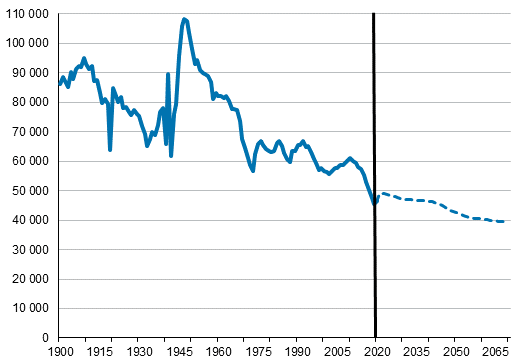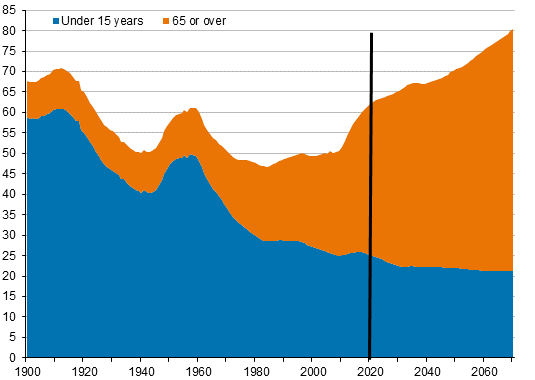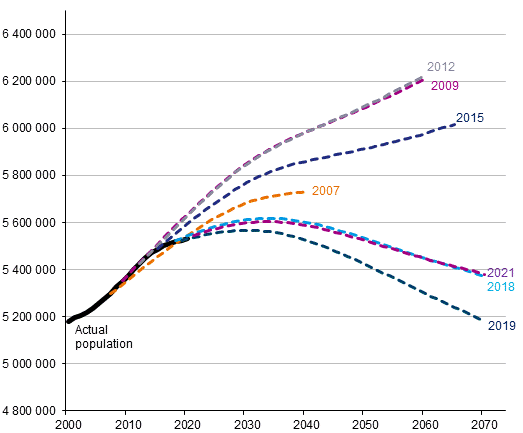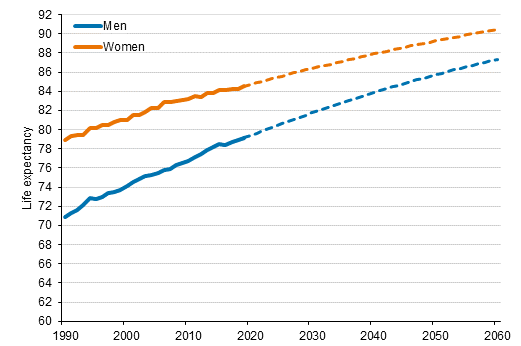Published: 30 September 2021
Birth rate in Finland is not sufficiently high for the age structure
According to Statistics Finland’s latest population projection, 700,000 more people would die than be born in Finland by the end of 2060 if the birth rate remained at the level observed now. In the 2060s, only under 40,000 children would be born in Finland per year. In the long term, the birth rate is not sustainable in terms of the age structure.
Number of live births in Finland in 1900 to 2020 and projection until 2070

Low birth rates have far-reaching effects
The current year is the fourth consecutive year when fewer than 50,000 children are born in Finland. These age groups will give birth 30 years from now. If the birth rate remains low for a long time, its reverberations will extend far into the future. At first, the effect is visible in the number of children born, but in the longer term also in the number of women of childbearing age.
In 2020, the number of births was higher than that of deaths in 53 municipalities. At the observed birth rate, there would be 39 corresponding municipalities in 2030 and only 15 in 2040.
According to the projection, the number of persons aged under 15 would be nearly 200,000 lower at the end of 2060 than at present. A protracted low birth rate would be visible in the size of the working-age population from the 2040s onwards and would also be reflected in the demographic dependency ratio.
Demographic dependency ratio* in 1900 to 2020 and projection until 2070

*) The number of those aged 15 or under and 65 or over per 100 working age persons
Population is projected to start declining in 2034
The year 2021 will be the sixth year in a row when deaths exceed births in Finland. According to the projection, net immigration will sustain population growth until 2034, when Finland’s population will be 5.6 million. After this, the population will turn to a decline and according to the projection, Finland’s population will already be lower in the 2050s than at present.
In 2020, the population grew in four regions and in Åland. According to the projection, the population would grow only in the regions of Uusimaa and Pirkanmaa and in Åland in 2040.
Comparison with previous projections
The 2021 population projection projects the population for 2060 to 5.45 million persons. The population projected for 2060 by Statistics Finland’s population projections made between 2007 and 2021 has varied between 5.3 and 6.2 million. This range reflects the uncertainty associated with population projections over the long term. The biggest difference between the projections made in different years is related to the birth rate assumption.
Population in 2000 to 2020 and projected population in projections made in 2007 to 2021

In the 2021 projection, the number of persons aged under 15 would be 712,000 in 2050, which is 152,000 lower than in the 2015 projection and 56,000 higher than in the 2019 projection.
The worst of the decline in the working-age population is over so far
The number of the population of working age (aged 15 to 64) was highest in Finland in 2009, when their number was 3.55 million in our country. Between 2010 and 2020, the number of working-age people has fallen by 136,000 in Finland. Over the next two decades, it is projected that the working-age population will decrease at a slower pace, i.e. by 76,000 persons by 2040.
Due to the low birth rate, the decline in the working-age population would accelerate in the 2040s. During 2041 to 2050, the working-age population would decrease by 103,000 persons and between 2051 and 2060 by further 133,000 persons. At the end of 2060, the working-age population would number 3.1 million people, which is good 310,000 fewer than at present.
The proportion of people of working age in the population is currently 62 per cent. According to the projection, the proportion will diminish to 60 per cent by 2040 and to 57 per cent by 2060. According to the 2021 projection, the proportion of the working-age population in total population will be higher until 2060 than in the projections made in 2012 and 2015, because due to the lower birth rate, the population will also turn to a decline.
Assumptions of the 2021 population projection
Statistics Finland's latest population projection assumes that the birth rate would remain constant in future. The imputed number of children that women give birth to during their lifetime, i.e. the total fertility rate is assumed to be 1.45.
The projection assumes that Finland’s migration gain from abroad will be 20,000 people during the current year and after that 15,000 people yearly.
The mortality rate is projected to continue declining throughout the projection period. The mortality rate of people aged under 50 is assumed to continue declining similarly to what has been observed when comparing the mortality rates for 1987 to 1991 and 2016 to 2020. The mortality rate of persons aged 50 and over is assumed to fall similarly as observed when comparing the mortality rate during the periods 1997 to 2001 and 2016 to 2020.
Men’s life expectancy is projected to lengthen by close on five years and women’s by good three years by 2040. More detailed information about the projection method can be found in the quality description.
Life expectancy at birth by sex in 1990 to 2020 and projection until 2060

The projection is a trend calculation and gives decision-makers a chance to react
Statistics Finland’s population projections are demographic trend calculations based on observations on past development in the birth rate, mortality and migration. The projections do not seek to estimate the effect of economic, socio-political regional policy and other such factors on population development.
According to the nature of trend calculations, the projection expects past developments to continue into the future. When preparing the projection, no stand is taken on how the size of the population should develop. When examining population projection figures, it should be borne in mind that the projection only indicates the expected population development if the recent development continues unchanged into the next decades.
The task of a population projection is to provide tools with which decision-makers can assess whether measures need to be taken to try to influence the population development. Decision-makers should assess the advisability of the population development indicated by the projection and, if necessary, take action to prevent the materialisation of the projection if the population development indicated by the projection is not desired.
The projection has been made for the whole country up to
2070 and regionally up to 2040.
The next population projection will be published in autumn
2024.
Source: Population projection 2021-2070. Statistics Finland
Inquiries: Markus Rapo 029 551 3238, vaesto.tilasto@stat.fi
Head of Department in charge: Hannele Orjala
Publication in pdf-format (308.0 kB)
- Tables
-
Tables in databases
Pick the data you need into tables, view the data as graphs, or download the data for your use.
Appendix tables
- Figures
-
- Appendix figure 1. Births, deaths, net immigration and population change in 1990 to 2020 and projection for 2021 to 2060 (30.9.2021)
- Appendix figure 2. Total fertility rate 1960 - 2020 (30.9.2021)
- Appendix figure 3. Population by age and gender 2020 (30.9.2021)
- Appendix figure 4. Population by age and gender 2060, projection 2021 (30.9.2021)
- Quality descriptions
Updated 30.9.2021
Official Statistics of Finland (OSF):
Population projection [e-publication].
ISSN=1798-5153. 2021. Helsinki: Statistics Finland [referred: 20.12.2025].
Access method: http://stat.fi/til/vaenn/2021/vaenn_2021_2021-09-30_tie_001_en.html

